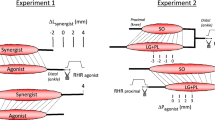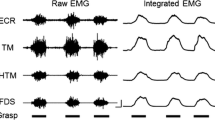Summary
The characteristics of vibration-induced illusory joint movements were studied in healthy human subjects. Unseen by the subject, constant frequency vibration trains applied to the distal tendon of the Triceps or Biceps induced an almost constant velocity illusory movement of the elbow whose direction corresponded to that of a joint rotation stretching the vibrated muscle. Vibration trains of the same duration and frequency applied alternatively to the Biceps and Triceps evoked alternating flexion-extension illusory movements.
During successive application of vibration trains at frequencies from 10 to 120 Hz, the perceived velocity of the illusory movements increased progressively from 10 to 70–80 Hz, then decreased from 80 to 120 Hz. The maximal perceived velocity was three times higher during alternating vibration of the Biceps and Triceps than during single muscle stimulation.
Unit activity from 15 muscle spindle primary endings and five secondary endings located in Tibialis anterior and Extensor digitorum longus muscles were recorded using microneurography in order to study their responses to tendon vibration and passive and active movements of the ankle.
Primary endings were all activated by low amplitude tendon vibration (0.2–0.5 mm) previously used to induce illusory movements of the elbow. The discharge of some was phase-locked with the vibration cycle up to 120 Hz, while others responded one-to-one to the vibration cycle up to 30–50 Hz, then fired in a sub-harmonic manner at higher frequencies. Secondary endings were much less sensitive to low amplitude tendon vibration.
Primary and secondary ending responses to ramp and sinusoïdal movements of the ankle joint were compared. During the movement, the primary ending discharge frequency was almost constant, while the secondary ending activity progressively increased. During ankle movements the primary ending discharge appeared mainly related to velocity, while some secondary activities seemed related to both movement velocity and joint angle position.
Muscle spindle sensory ending responses to active and passive ankle movements stretching the receptor-bearing muscle (plantar flexion) were qualitatively and quantitatively similar. During passive reverse movements (dorsiflexion) most of the sensory endings stopped firing when their muscle shortened. Active muscle shortening (isotonic contraction) modulated differently the muscle spindle sensory ending discharge, which could stop completely, decrease or some times increase during active ankle dorsiflexion. During isometric contraction most of the muscle spindle sensory endings were activated.
The characteristics of the vibration-induced illusory movements and the muscle spindle responses to tendon vibration and to active and passive joint movements strengthened the possibility of the contribution of primary endings to kinaesthesia, as suggested by several previous works. Moreover, the present results led us to attribute to proprioception in the muscle stretched during joint movement a predominant, but not exclusive, role in this kind of perception.
Similar content being viewed by others
References
Albe-Fessard D, Liebeskind J (1966) Origine des messages somatosensitifs activant les cellules du cortex moteur chez le Singe. Exp Brain Res 1: 127–146
Bianconi R, Van der Meulen JP (1963) The response to vibration of the end organs of mammalian muscle spindles. J Neurophysiol 26: 177–190
Boyd PR, Roberts TDM (1953) Proprioceptive discharges from stretch receptors in the knee joint of the cat. J Physiol (Lond) 122: 38–58
Brindley GS, Merton PA (1960) The absence of position sense in the human eye. J Physiol (Lond) 153: 127–130
Brown MC, Crow A, Matthews PBC (1965) Observations on the fusimotor fibres of the tibialis posterior muscle in the cat. J Physiol (Lond) 177: 140–159
Brown MC, Engberg I, Matthews PBC (1967) The relative sensitivity to vibration of muscle receptors of the cat. J Physiol (Lond) 192: 773–800
Browne K, Lee J, Ring PA (1954) The sensation of passive movement at the metatarso-phalangeal joint of the great toe in man. J Physiol (Lond) 126: 448–458
Burgess PR, Clark FJ (1969) Characteristics of knee joint receptors in the cat. J Physiol (Lond) 203: 301–315
Burke D, Hagbarth KE, Lofstedt L, Wallin BG (1976) The response of human muscle spindle endings to vibration of non contracting muscles. J Physiol (Lond) 261: 673–693
Burke D, Hagbarth KE, Lofstedt L (1978a) Muscle spindle activity in man during shortening and lengthening contractions. J Physiol (Lond) 277: 131–142
Burke D, Hagbarth KE, Skuse NF (1978b) Recruitment order of human spindle endings in isometric voluntary contractions. J Physiol (Lond) 285: 101–112
Chambers RA, Gilliat RW (1954) The clinical assessment of postural sensation in the fingers. J Physiol (Lond) 123: 42p
Clark FJ, Matthews PBC, Muir RB (1979) Effect of the amplitude of muscle vibration on the subjectively experienced illusion of movement. J Physiol (Lond) 296: 14–15P
Echlin F, Fessard A (1938) Synchronized impulses discharges from receptors in the deep tissues in responses to a vibrating stimulus. J Physiol (Lond) 93: 321–334
Eklund G (1972) Position sense and state of contraction; the effects of vibration. J Neurol Neurosurg Psychiatry 35: 606–611
Ferrell WR (1980) The adequacy of stretch receptors in the cat knee joint for signalling joint angles throughout a full range of movement. J Physiol (Lond) 299: 85–99
Gelfan S, Carter S (1967). Muscle sense in man. Exp Neurol 78: 469–473
Goodwin GM, McCloskey DI, Matthews PBC (1972) The contribution of muscle afferents of kinaesthesia shown by vibration induced illusions of movement and by the effects of paralysing joint afferents. Brain 95: 705–748
Grigg P (1975) Mechanical factors influencing the response of joint afferent neurons from the cat knee. J Neurophysiol 38: 1473–1484
Hagbarth KE (1973) The effect of muscle vibration in normal man and in patients with motor disorders. In: Desmedt JE (ed) New developments in electromyography and clinical Neurophysiology, vol 3. Karger, Basel, pp 428–443
Hagbarth KE, Vallbo AB (1968) Discharge characteristics of human muscle afferents during stretch and contraction. Exp Neurol 22: 674–694
Juta AJA, Van Beekum WT, Denier Van Dergon JJ (1979) An attempt to quantify vibration induced movement sensation. J Physiol (Lond) 292: 18P
Landgren S, Silfvenius H (1969) Projection to cerebral cortex of group I muscle afferents from cat's hind-limb. J Physiol (Lond) 200: 353–372
Lloyd DPC, McIntyre AK (1950) Dorsal column conduction of group I muscle afferent impulses and their relay through Clarke's column. J Neurophysiol 13: 39–54
McCloskey DI (1978) Kinesthetic sensibility. Physiol Rev 58: 763–820
McIntyre AK (1953) Cortical projection of afferent impulse in muscle nerves. Proc Univ Otago Med School 31: 5–6
McIntyre AK (1978) Deep somatic sensibility: A re-appraisal. Proc Aust Physiol Pharmacol Soc 9: 61–68
Matthews PBC (1977) Muscle afferents and kinaesthesia. Br Med Bull 33: 137–142
Matthews PBC, Simmonds A (1974) Sensations of finger movement elicited by pulling upon flexor tendons in man. J Physiol (Lond) 239: 27–28P
Matthews PBC, Stein RB (1969) The sensitivity of muscle spindle afferents to small sinusoidal change of length. J Physiol (Lond) 200: 723–743
Mountcastle VB, Powell T (1959) Central nervous mechanisms subserving position sense and kinesthesis. Bull Johns Hopkins Hosp 105: 173–200
Mountcastle VB, Covian MR, Harrison CR (1952) The central representation of some forms of deep sensibility. Res Publ Assoc Res Nerv Ment Dis 30: 339–370
Oscarsson O, Rosen I (1963) Projection to cerebral cortex of large muscle spindle afferents in forelimb nerves of the cat. J Physiol (Lond) 169: 924–945
Phillips CG, Powell TPS, Wiesendanger M (1971) Projection from low threshold muscles afferents of hand and forearm to area 3a of Baboon's cortex. J Physiol (Lond) 217: 419–446
Prochazka A, Stephens JA, Wand P (1979) Muscle spindle discharge in normal and obstructed movements. J Physiol (Lond) 287: 57–66
Provins KA (1958) The effect of peripheral nerve block on the appreciation and execution of finger movements. J Physiol (Lond) 143: 55–67
Roland PE (1978) Sensory feedback to the cerebral cortex during voluntary movement in man. Behav Brain Sci 1: 129–171
Roll JP, Gildhodes JC, Tardy-Gervet MF (1980) Effets perceptifs et moteurs des vibrations musculaires chez l'Homme normal. Mise en évidence d'une réponse des muscles antagonistes. Arch Ital Biol 118: 51–71
Roll JP, Vedel JP (1980) Contribution des afférences fusoriales au codage du mouvement et des positions: Approche neurographique chez l'Homme. J Physiol (Paris) (in press)
Rose JE, Mountcastle VB (1959) Touch and kinesthesis. In: Field J (ed) Handbook of physiology, vol 1. Pentland, Edinburgh London, pp 387–429
Sperry RW (1950) Neural basis of the spontaneous optokinetic response produced by visual neural inversion. J Comp Physiol Psychol 43: 482–489
Vallbö AB (1974) Afferent discharge from human muscle spindles in non-contracting muscles. Steady state impulse frequency as a function of joint angle. Acta Physiol Scand 90: 303–318
Author information
Authors and Affiliations
Rights and permissions
About this article
Cite this article
Roll, J.P., Vedel, J.P. Kinaesthetic role of muscle afferents in man, studied by tendon vibration and microneurography. Exp Brain Res 47, 177–190 (1982). https://doi.org/10.1007/BF00239377
Received:
Issue Date:
DOI: https://doi.org/10.1007/BF00239377




